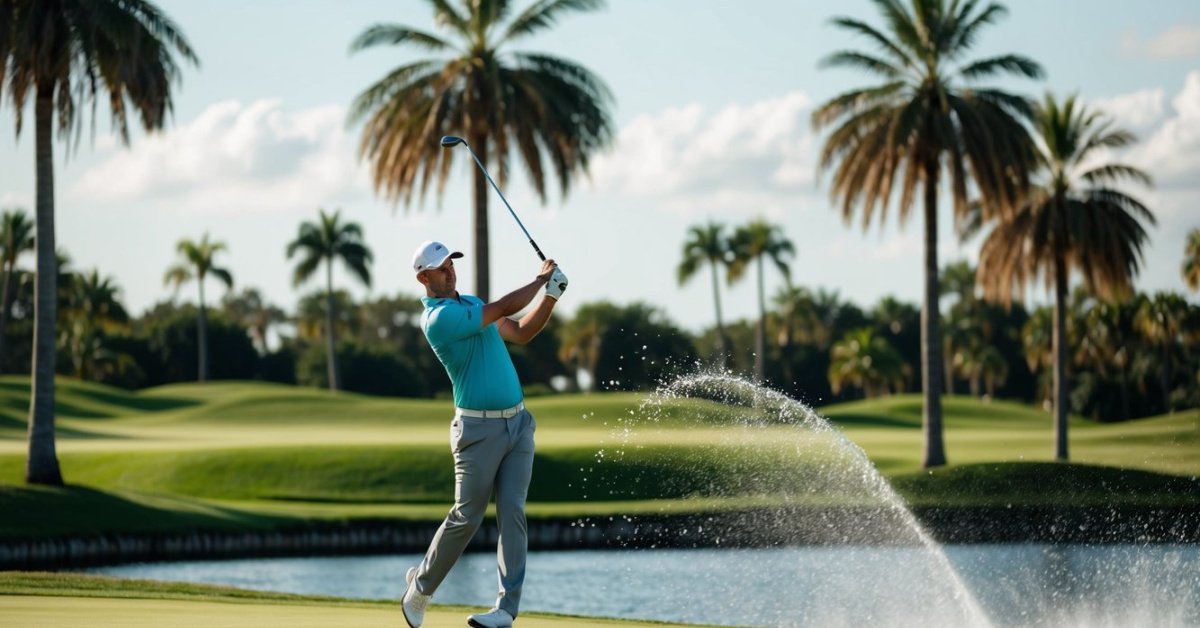Ever wondered about the humble beginnings of the golf ball? It’s a piece of sports equipment we often take for granted, but its history is as rich and fascinating as the game itself. From wooden origins to the dimpled beauties we know today, the evolution of the golf ball is a tale of innovation and ingenuity.
The Origins of Golf Balls
If you’re deep into the history of the game, you’ve probably wondered about the origins of the golf balls you drive down the fairway. Golf balls have a storied past, emerging from the shrouded mists of golf’s origins. They started as simple feathery spheres and evolved into the high-tech equipment you trust for your low handicap game today.
Back in the day, the earliest known golf balls date to the late 14th century. They were made of wood, specifically hardwoods like beech or boxroot, and were crafted by carpenters. These were clunky and didn’t fly far, but they were the first iteration in what would become a centuries-long quest for the perfect golf ball.
By the 17th century, the feathery appeared. Made of leather and stuffed with bird feathers, these balls were a big step up. Despite being time-consuming and costly to make, they were significantly superior in flight compared to their wooden predecessors. A skilled craftsman could produce only a few balls in a day, and these featheries remained the gold standard until the mid-19th century. It’s fascinating to think that the feathery was actually boiled to allow the feathers to expand, filling the leather cover and making the ball hard.
Around 1848, the Gutta-Percha ball, or “guttie”, revolutionized the game. Made from the sap of the Gutta-Percha tree, this ball was cheaper and easier to produce. More importantly for players like you, it could be hit a considerable distance, and with repeated use, its surface became roughened, greatly improving its aerodynamics.
- Early wood balls
- 17th century feathery balls
- 19th century gutta-percha balls
Each innovation in golf ball development coincides with changes in the game itself — equipment, rules, and playing styles. Golfers shaped balls differently back then, relying on craftsmen to produce the best ball for a successful game. You can see how the evolution has not just been about the equipment but also the artistry and skill that goes into every aspect of the game.
The Evolution of Golf Balls
As you delve deeper into the world of golf, it’s fascinating to see how the golf ball has evolved from its rudimentary beginnings. Imagine navigating the fairways with bulky wooden spheres; that’s what golfers had to contend with in the late 14th century. But the game you love today owes much to the relentless pursuit of innovation.
By the 17th century, the feathery ball was all the rage. Though it sounds like something from a quaint period drama, these leather-coated golf balls stuffed with bird feathers were no joke. Their flight was superior to the wooden predecessors, and they became the standard – if your purse could handle the hefty price of handcrafted quality.
Fast forward to the mid-19th century, and enter the “guttie.” The Gutta-Percha ball not only brought golf to the masses with its affordability but also changed the game on a technical level. The guttie’s improved aerodynamics demanded new techniques; creating backspin was suddenly on the table. Adjusting your swing to the new ball dynamics was as crucial then as choosing the right club is for you today.
« What to Do When Hit by a Golf Ball: Essential Safety Tips & Steps
Golf Ball with Face: Unlock Personal Style & Focus on the Course »
With the introduction of the rubber Haskell ball in the early 20th century, the game transformed again. The layering of materials allowed for even more control and distance. As you refine your low-handicap gameplay, consider how these layers influence your precision and allow you to shape your shots with confidence.
- Wooden Balls: 14th Century
- Feathery Balls: 17th Century
- Gutta-Percha Balls: Mid-19th Century
- Rubber Haskell Balls: Early 20th Century
Taking a stroll through the timeline of golf ball development is like walking the course of history—a testament to how innovation continually shapes your approach to the game. With each technological advance, your gear does more than meet the eye; it challenges you to adapt, strategize, and improve. As the game advances, so do the tools of the trade, gearing you up for that next level of mastery on the greens.
Wooden Golf Balls
Imagine strolling down the fairway, with a club in hand that bears little resemblance to your current titanium driver. You’re about to strike a golf ball that’s nothing like the multi-layered spheres you’re accustomed to. This scenario would have been your reality had you been playing golf in the late 14th century. The very first golf balls were simple wooden spheres.
Crafted from hardy woods such as beech or box, these wooden golf balls were the game’s standard until the 17th century. While they lacked the refined aerodynamics of today’s selections, they did offer golfers of the era a challenging yet straightforward approach to the game. Without the technology we have today, the primary focus was on the golfer’s skill rather than the equipment.
It’s fascinating to think about how these wooden balls required a totally different technique and approach. You’d have to rely far more on your swing’s power and your strategic eye to gauge just the right angle, as getting them airborne and towards the hole was no small feat. And let’s not overlook the craftsmanship required to make these balls as round and smooth as possible, ensuring they were fit for the course.
Interestingly, despite their rudeness by our standards, these early wooden balls were integral in developing the game you love today. They laid the foundation for the innovative leaps in golf ball design to come. Just imagine what your scorecard might look like if you were playing with wooden golf balls right now. That’s quite a thought to ponder as you reach for your precisely engineered ball, ready to take your next shot on the modern course.
Feather Golf Balls
Before you could whip out the latest multilayer, urethane-covered marvel from your golf bag, players in the 17th century were taking their swings at the ‘feathery’. Handcrafted with painstaking detail, these feather golf balls were the sport’s standard until the mid-1800s. If you’re a purist at heart or a curious history buff, picture this: each ball was a small pouch of cowhide, shaped while wet, stitched snug, and packed full of goose or chicken feathers.
The crafting of a feathery was no casual endeavor. It was an art form that required skill and considerable muscle. The feathers were boiled and stuffed tightly into the leather cover until it nearly burst. As the leather dried, it shrunk, and the feathers expanded, creating a dense, hard ball. Due to the labor-intensive process, a maker could produce only a handful per day, which made featheries relatively expensive and not accessible to every aspiring golfer like you.
Performance-wise, these crafted orbs had their quirks. On a dry day, you’d be amazed at how far they flew, nearing distances of 150 to 200 yards with the strike of a good clean swing. Yet, introduce a touch of Scottish mist or a downpour, and the feathery became a sodden, heavy lump, unlikely to roll much further than your foot could kick it. This inherent drawback meant that your ancestors had to adapt their play according to the weather—not unlike today, but certainly with a more palpable sense of defeat when the elements were against them.
Of course, mastering the feathery demanded a high level of expertise from golfers who were, in some respects, more akin to artists or alchemists than athletes. It was a time when golf was as much about overcoming the imperfections of the equipment as it was about skill, strategy, and power. With the feathery’s quirks, it’s no wonder the quest for a more reliable and consistent golf ball persisted, eventually leading to the innovations that followed.
Gutta-Percha Golf Balls
So, you’ve mastered the featheries, but as you already know, technology marches on, and the mid-19th century brought a game-changer: the gutta-percha golf ball. Gutta-percha, derived from the dried sap of the sapodilla tree, introduced a new era in golf. These balls were known as “gutties” for short and offered a much more durable and affordable option compared to their feathery predecessors.
The creation of gutties began initially as solid, smooth-surfaced spheres, a stark contrast to the hand-crafted feather golf balls. They were significantly easier to produce and could be molded into shape when heated, slashing production costs and time significantly. As a low handicapper, you’d appreciate that a guttie could be reshaped when it started to wear, giving you a lot more mileage out of a single ball.
Interestingly, gutties had a quirk: they flew further when their surfaces were roughed up. It wasn’t long before golfers and manufacturers alike noticed that nicked and chipped balls performed better. This accidental discovery led to the intentional design of golf ball dimples that you are no stranger to.
Performance-wise, gutties marked a definite improvement over feather balls, particularly in the wet conditions that so often plague our beloved greens. They didn’t soak up water like featheries did, maintaining their integrity and flight characteristics regardless of the weather. These balls also changed the nature of the game; they were harder, which meant they could be hit further, and golf courses started to stretch out in response.
Though not as lively or as long-flying as modern balls, gutties were a significant stepping stone in the evolutionary ladder of golf balls. They made golf more accessible to the masses—so much that the game’s popularity surged. Manufacturers began experimenting with surface patterns, leading to an era of innovation that directly links to today’s dimpled designs. You can trace part of your game’s legacy to these humble beginnings, where simplicity met function and expanded golf into the widespread sport it is today.
The Modern Golf Ball
As you’ve refined your swing and lowered your handicap, you’ve probably grown to appreciate the engineering marvel that is the modern golf ball. The transformation these little spheres have undergone is staggering, especially over the last few decades. Manufacturers have mastered the art of golf ball design, creating products that cater to every aspect of your game, whether that be distance, control, or feel.
Let’s dive into the rubber-core era, which started in the early 20th century. These modern marvels, known as “Haskell” balls, were a stark departure from the one-piece gutties of yesteryear. With a solid rubber core wrapped in high-tension rubber thread and a gutta-percha cover, they offered a resilience previously unseen on the golf course. The result? Shots that flew higher and longer, much to every golfer’s delight.
Fast forward a bit, and you’ll encounter the introduction of the two-piece golf ball in the mid-20th century. Aimed at the everyday golfer, these balls boasted a durable Surlyn cover wrapped around a firm rubber core, prioritizing distance above all else. They were a hit among high-handicappers for their cut-resistant nature and affordability.
As your skill level climbed, you might’ve taken note of how the golf ball landscape expanded to cater to players like yourself. Enter the multi-layered balls, boasting three, four, or even five layers, each serving a distinct purpose. These advanced designs provided a nuanced solution for players seeking the optimal balance between distance and spin. Take a peek at any high-level tournament, and you’ll see pros carefully selecting their ball based on how it complements their play style – a testament to the bespoke nature of modern golf balls.
Nowadays, the golf ball’s cover material often comes down to a choice between Urethane and Surlyn. Urethane, softer and more spin-friendly, enables skilled players to exert incredible control around the greens. Surlyn, on the other hand, offers durability and a lower spin profile, making it the go-to for golfers looking to maximize their tee shots.
Conclusion
You’ve journeyed through the fascinating evolution of golf balls from their humble beginnings to the high-tech spheres that grace the greens today. Remember, next time you tee off with a state-of-the-art ball, it’s not just a piece of equipment—it’s a testament to centuries of innovation and passion for the game. Whether you’re opting for control with Urethane or durability with Surlyn, you’re part of a tradition that’s as rich as the sport itself. Here’s to enjoying every drive, chip, and putt with a little more appreciation for the history behind your golf ball!
Frequently Asked Questions
What are “gutties” in golf?
Gutties are golf balls from the mid-19th century made from the dried sap of the sapodilla tree. They were more durable and affordable than earlier feather golf balls.
How did gutta-percha golf balls change the game?
Gutta-percha balls, or gutties, allowed for longer shots, performed better in wet conditions, were easier to produce and could be reshaped when worn. Their introduction led to a surge in golf’s popularity.
What was the significance of surface patterns on golf balls?
Surface patterns on golf balls, like dimples, were significant innovations that helped improve the aerodynamics of golf balls, allowing them to travel further and with more stability.
How did the modern golf ball evolve?
The modern golf ball has evolved through several stages, including the rubber-core era, the development of two-piece golf balls, and multi-layered balls designed for specific playing characteristics like distance, control, and feel.
What is the difference between Urethane and Surlyn golf ball covers?
Urethane covers on golf balls offer more control and a softer feel, making them preferred by players who prioritize precision. Surlyn covers are more durable and provide a lower spin profile, fitting for players seeking distance and reduced wear.











